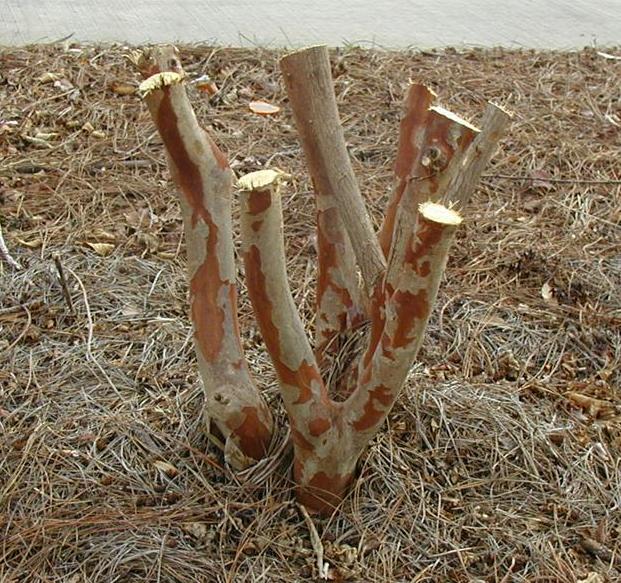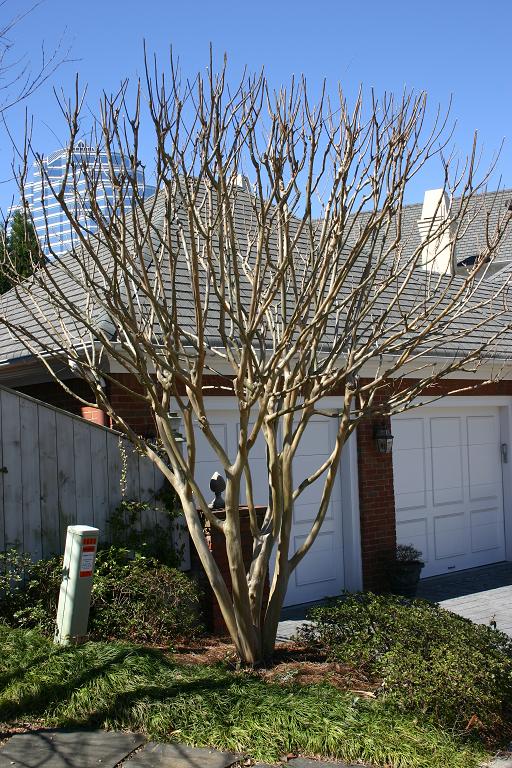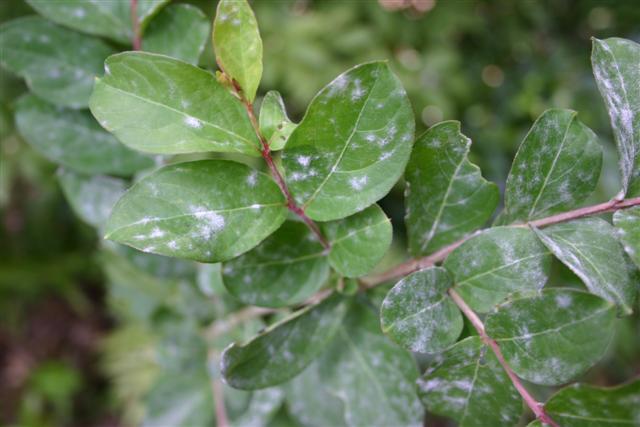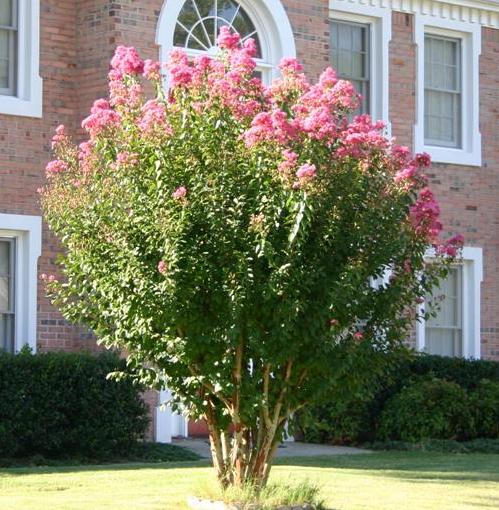Georgia Gardener Newsletter Design Tip: July 23, 2009
Crape Myrtles in the Garden
Crape Myrtle Culture
Crape myrtles are extremely popular plants in the southern parts of the U.S. and for good reason. They bloom during the hottest
part of the summer when few other trees and shrubs have any flowers, tolerate a wide range of soil conditions, grow
quickly, have a broad range of flower colors, a long bloom season (60-120 days) and are easy to grow. What's not to like.
On the downside, they
are used so much in landscapes that people get bored with them. As a designer, I was reluctant to use them only because everyone
had them. However there are so many different sizes and colors, I think using crape myrtles in landscapes more
often deserves some consideration.
The growing requirements for crape myrtles are really simple: full sun and well-drained soil. Crape myrtles will tolerate
sandy soils, clay soils, rocky soils, etc. What they WON'T tolerate are soils that are poorly draining or stay damp/wet.
Plant crape myrtles in full sun. By full sun, I mean 6-8 hours of continuous, direct, unbearable, miserably hot Georgia sun.
If the location you've selected is so hot and sunny that you don't want to stand there in July and August, it's the right spot.
Planting crape myrtles in less than 6 hours of sun will reduce the flowering and increase the problems with powdery mildew.
For purposes of this article, I've divided crape myrtles into somewhat arbitrary categories: Small (under 5 feet), Medium
(6-12 feet) and Large (over 12 feet). Those that are under 5 feet tall are usually maintained in shrub form while those
over 5 feet are usually maintained in tree-form, often with multiple trunks. See the section on pruning below for
more details.
Small Crape Myrtles: To 5 Feet
While researching this topic, I was surprised to find such a large number of small crape myrtles. I think that nurseries
should consider providing more crapes in this category because of the smaller size of many landscapes. Crape myrtles of this
size can be massed together as a deciduous hedge or even grown as a groundcover or in containers.
| Name
|
Height
|
Color
|
Bloom Time
|
Mildew Resistance
|
| Rosy Carpet |
1-2 |
Rosy Pink |
Late June-July |
Good |
| Sacramento |
2-3 |
Red |
Mid/Late July |
Good |
| Pocomoke |
2-3 |
Dark Pink |
Mid/Late July |
Very Good |
| Baton Rouge |
2-3 |
Red/Pink |
July |
Fair |
| Delta Blush |
2-3 |
Light Pink |
June-July |
Fair |
| New Orleans Myrtlette Weeping |
2-3 |
Purple |
Mid/Late July |
Fair |
| Pink Blush |
2-3 |
Light Pink |
Mid/Late July |
Fair |
| World's Fair Weeping |
2-3 |
Red/Pink |
Mid/Late July |
Fair |
| Weeping Alamo Fire |
2-3 |
Red |
July |
Fair |
| Chickasaw |
2-4 |
Medium Pink |
Mid/Late July |
Very Good |
| Chica Pink |
2-4 |
Pink |
Mid/Late July |
Fair |
| Chica Red |
2-4 |
Red |
July |
Fair |
| Tightwad Red |
2-4 |
Red |
July |
Very Good |
| Firecracker |
3-5 |
Light Red |
Mid/Late July |
Very Good |
| Ozark Spring |
3-5 |
Purple |
Early July |
Good |
| Velma's Royal Delight |
3-5 |
Red/Pink |
Mid/Late July |
Good |
| Victor |
3-5 |
Red |
June-July |
Very Good |
| Dwarf Low Flame |
3-5 |
Red |
Late July |
Good |
| McFadden's Pinkie |
3-5 |
Light Pink |
Late June-July |
Very Good |
Medium Crape Myrtles: 6-12 Feet
These varieties are what I call the middle of the road. They are outstanding small trees that can be grown in smaller landscapes
or even in large containers. They look nice massed together in groups or as stand-alone specimens.
| Name
|
Height
|
Color
|
Bloom Time
|
Mildew Resistance
|
| Okmulgee |
6 |
Dark Red |
Mid/Late July |
Fair |
| Petite Embers |
6 |
Dark Pink |
Mid/Late July |
Fair |
| Petite Orchid |
6 |
Purple |
Mid/Late July |
Fair |
| Petite Pinkie |
6 |
Pink |
Mid/Late July |
Fair |
| Petite Plum |
6 |
Purple |
Mid/Late July |
Fair |
| Petite Red Imp |
6 |
Red |
Early July |
Fair |
| Petite Snow |
6 |
White |
Early/Mid July |
Fair |
| Dwarf Royalty |
6-8 |
Purple |
Mid/Late July |
Good |
| Caddo |
6-10 |
Pink |
Mid July |
Very Good |
| Hopi |
6-10 |
Medium Pink |
Late June-July |
Very Good |
| Pecos |
6-10 |
Medium Pink |
July |
Very Good |
| Prairie Lace |
6-10 |
Red & White |
June |
Good |
| Tonto |
6-10 |
Dark Pink |
July |
Very Good |
| Mandi |
6-12 |
Dark Red |
Mid/Late July |
Fair |
| Acoma |
8-10 |
White |
Mid June |
Very Good |
| Christiana |
8-10 |
Dark Red |
Mid/Late july |
Fair |
| Coral Sport |
8-10 |
Coral |
Early July |
Fair |
| Firebird |
8-10 |
Watermelon |
Mid/Late July |
Fair |
| Zuni |
8-12 |
Purple |
Late July |
Very Good |
| Centennial Spirit |
8-12 |
Red |
July |
Very Good |
| Cheyenne |
8-12 |
Red |
Mid/Late July |
Very Good |
| Pepperment Lace |
8-12 |
Pink & White |
Early July |
Fair |
| Burgundy Cotton |
10-12 |
White |
Late June-July |
Fair |
Large Crape Myrtles: Over 12 feet
These are the true tree-form varieties of crape myrtle. Most of these are grown with multi-trunks and some have very interesting
bark. Make sure to allow enough space for these plants to reach their mature size. The width of these plants varies, but you
can usually count on it being 1/2 to 2/3 of the height. This should help you with proper spacing. This is the largest group of
crape myrtles.
| Name
|
Height
|
Color
|
Bloom Time
|
Mildew Resistance
|
| Yvonne |
12-15 |
Medium Pink |
Early July |
Good |
| New Snow |
12-15 |
White |
Early July |
Good |
| Comanche |
12-18 |
Medium Pink |
Mid July |
Good |
| Conestoga |
12-18 |
Medium Pink |
Mid July |
Good |
| Byer's Regal Red |
12-20 |
Red |
Mid July |
Good |
| Catawba |
12-20 |
Purple |
Mid July |
Good |
| Lipan |
12-20 |
Purple |
Mid July |
Very Good |
| Osage |
12-20 |
pink |
Early July |
Very Good |
| Powhatan |
12-20 |
Dark Purple |
Late July |
Good |
| Royal Velvet |
12-20 |
Dark Pink |
Late June |
Good |
| Seminole |
12-20 |
Bright Pink |
Mid June |
Good |
| Yuma |
12-20 |
Light Purple |
Late July |
Very Good |
| Country Red |
15-20 |
Red |
Mid July |
Very Good |
| Country Red |
15-20 |
Red |
Mid July |
Very Good |
| Sioux |
15-20 |
Pink |
Late July |
Very Good |
| William Toovey |
15-20 |
Pink |
Mid July |
Good |
| Byer's White |
15-20 |
White |
Late June |
Good |
| Sarah's Favorite |
15-20 |
White |
Mid June |
Very Good |
| Townhouse |
15-20 |
White |
Early July |
Very Good |
| Near East |
15-20 |
Light Pink |
Late June |
Fair |
| Raspberry Sundae |
15-20 |
Red/Pink |
Mid July |
Good |
| Twilight |
15-20 |
Purple |
Early/Mid July |
Fair |
| Apalachee |
18-22 |
Light Purple |
Mid July |
Very Good |
| Byer's Hardy Lavender |
20-25 |
Purple |
Mid July |
Very Good |
| Dallas Red |
20-25 |
Red |
Early July |
Good |
| Dynamite |
20-25 |
Bright Red |
Early July |
Very Good |
| Potomac |
20-25 |
Pink |
Late June |
Very Good |
| Red Rocket |
20-25 |
Red |
Mid July |
Good |
| Tuscarora |
20-25 |
Dark Pink |
Early July |
Very Good |
| Tuskegee |
20-25 |
Dark Pink |
Late June |
Very Good |
| Arapaho |
20-25 |
Red |
June-July |
Very Good |
| Carolina Beauty |
20-25 |
Dark Red |
Early July |
Good |
| Glendora White |
20-25 |
White |
Early July |
Fair |
| Special Red |
20-25 |
Coral-Red |
Early July |
Fair |
| Watermelon Red |
20-25 |
Red |
Early July |
Fair |
| Choctaw |
25-30 |
Pink |
Mid July |
Very Good |
| Miami |
25-30 |
Coral/Pink |
Early July |
Very Good |
| Muskogee |
25-30 |
Light Purple |
Mid June |
Very Good |
| Wichita |
25-30 |
Light Purple |
Early July |
Very Good |
| Biloxi |
25-30 |
Pink |
Mid July |
Very Good |
| Natchez |
25-30 |
White |
Mid June |
Very Good |
| Kiowa |
30-35 |
White |
Late June |
Very Good |
| Basham's Party Pink |
30-35 |
Purple |
Late June |
Good |
| Fantasy |
30-35 |
White |
Late June |
Very Good |
Proper Pruning
Two years ago, I attended a conference of Certified Arborists in which one of the lectures was about a lengthy research project that
had been conducted on the pruning of crape myrtles. Several pruning techniques were applied to groups of crapes to determine
if there were differences observed in bloom time, flower size and total flower mass. The results were interesting. Pencil pruning,
the labor-intensive technique of removing smaller branches and cutting back longer branches to pencil diameter, seemed to produce
the best overall results in terms of flower number and mass without affecting bloom time. Topping (aka crape murder) produced
more new growth with good but delayed flowering and other side effects. No pruning at all seemed to have little effect on
flower size and number. Which type of pruning technique you choose depends upon how much time you have and what you want the
plant to look like in the winter and summer.
Most professionals are opposed to topping for several reasons. Repeated hard pruning is stressful on a plant. On crape myrtles,
you often see hard-pruned plants develop knobs at the pruning site. New growth tends to be weak and may actually weep over
when full of flowers. I have observed that murdered crape myrtles tend to be more susceptible to powdery mildew and tend to
put out more suckers at the base. In my opinion, the best pruning technique is pencil pruning followed closely by no pruning at all.
Pruning crape myrtles is done in the winter from January through early March.

|

|
|
Crape Murder
|
A Properly Pruned Crape Myrtle
|
Pests and Diseases
Although pretty tough landscape plants, crape myrtles do have issues with a few pests of which most are not serious. The most
serious pest of crape myrtles is the Asian Ambrosia Beetle. This insect bores into the trunk and larger limbs of crape myrtles
in order to lay its eggs. After laying her eggs, the female introduces a fungus to the egg chamber in order to feed her
developing young. Unfortunately, the fungus grows and clogs the plant's vascular system. Even with light infestations, everything
above the lowest egg chamber can die. The most common sign is the appearance of toothpick-like projections from the trunk.
Fortunately it is possible to cut the crape myrtle back to the ground and start over. Other plants affected by AAB aren't so
lucky. Once infected, there is no cure. Preventative sprays of what I call the "thrin" pesticides to keep the beetles off the tree
can be somewhat successful in February or March. These products include cypermethrin, permethrin, deltamethrin and bifenthrin (which
must be applied by a licensed professional).
Aphids are extremely common on crape myrtles and are the pest usually responsible for the black film that coats the leaves,
limbs, trunks, ground and plants nearby. As aphids consume the plant tissue, they excrete honeydew which is high in sugar.
Sooty mold grows in the honeydew excretion giving the plant the black look. Once coated, it's nearly impossible to wash off.
Although unsightly, it usually not harmful in the long term and usually disappears over the fall and winter.
Preventing the sooty mold involves controling the aphids either with
yearly applications of systemic insecticides (such as Imidacloprid*) in early spring, seasonal sprayings with products labeled for aphids or by
using a strong blast from the hose to wash the aphids off.
Japanese beetles are a seasonal pest of crape myrtles. They usually appear in early June in large numbers and tend to congregate
on crape myrtles in what can only be described as a feeding-sex orgy. Usually they are gone in several weeks and since crape myrtles
have such a long bloom period, it rarely disrupts the flowering enough to be a huge problem. If you want to control Japanese
beetles, there are several insecticides labeled for that including sevin, malathion, insecticidal soap, etc. Personally, there
are so many of these bugs, I don't bother trying to control them. I simply wait for them to go away. Applications of the
systemic Imidacloprid* do seem to show some control. This must be applied in the early spring.
One disease is found fairly commonly on crape myrtles and that is powdery mildew. This fungal disease usually appears in
early to mid summer and looks as if the plants have been dusted with a silver-gray powder (see below). Usually by the time it appears, control
is going to be difficult. Repeated severe infections of powdery mildew can weaken the plants but usually it's considered
more unsightly than damaging. Control of powdery mildew involves the spraying of fungicides before the disease gets going.
My suggestion to avoid having to use fungicides repeatedly for powdery mildew control is to select only those varieties of
crape myrtles with very good or good resistance and to plant them in full sun. Hard pruning of crape myrtles also seems to be
associated with higher infections of the disease. So, go easy with the pruners.

With so many choices in size and color, I recommend that if you have a sunny landscape and want to add some summer color, consider
putting in some crape myrtles. They are widely available at almost every nursery. As for companion plants, try
Knockout roses, daylilies, coneflowers, black-eyed Susans, summer annuals, etc.
Additional Information
For more information, go to this web site from
Texas A&M University.
It has pictures of many cultivars.
Copyright © 2009 by Theresa Schrum - All rights reserved
No part of this website may be reproduced without the expressed written permission of Theresa Schrum




